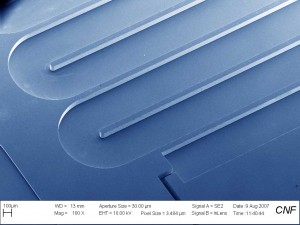Drug and toxicity testing with body-on-a-chip systems:
High quality, in vitro screening tools are essential in identifying promising compounds during drug development. Tests with currently used cell-based assays only provide an indication of a compound’s potential therapeutic benefits to the target tissue, but not the whole body. Data obtained with animal models often can not be extrapolated to humans. Multi-compartment microfluidic based devices, particularly those that are physical representations of physiologically based pharmacokinetic (PBPK) models, may contribute to improving the drug development process. These scaled down devices, called micro cell culture analogs (µCCAs) or “body-on-a-chip”, can simulate multi-tissue interactions under near physiologic fluid flow conditions and realistic tissue-tissue ratios. Since the device can be used with both animal and human cells, it can facilitate cross species extrapolation. Used in conjunction with PBPKs the devices permit an estimation of effective concentrations that can be used for studies with animal models or predictors of human response. The devices also provide a means for relatively high throughput screening of drug combinations and, when utilized with a patient’s tissue sample, an opportunity for individualized medicine.


